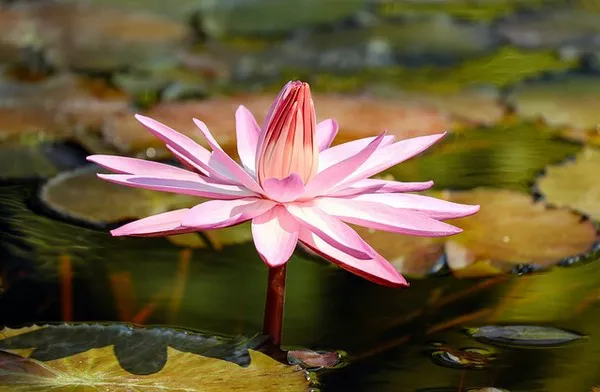Flowers have long held a significant place in human culture, communicating emotions, sentiments, and messages without the need for words. Among these floral messengers, the lily stands as a striking emblem of purity, beauty, and spirituality. With its captivating appearance and rich history, the lily flower has become a profound symbol in various societies across the globe, each attributing its own unique meaning to this elegant blossom.
A Glimpse into the Lily’s Appearance and History
The lily, scientifically known as Lilium, is renowned for its intricate and graceful petals that radiate from a central axis. Its beauty and elegance have captured the hearts of countless admirers throughout history. Belonging to the Liliaceae family, the lily encompasses numerous species and varieties, each with its own distinct features and symbolism.
The origin of the lily’s symbolic significance can be traced back to ancient civilizations. In Ancient Greece, the lily was associated with goddesses like Hera and Venus, representing both maternal and romantic love. In Ancient Rome, the lily was a symbol of wealth and prosperity. The Madonna lily, often depicted in Christian art, became a symbol of purity and virtue, linked to the Virgin Mary and her divine attributes.
Delving into the Profound Symbolism
1. Purity and Innocence
Perhaps the most prevalent and enduring symbolism associated with the lily is purity and innocence. Its pristine white petals, often reminiscent of snow or clouds, have made it a quintessential representation of purity across cultures. This symbolism is deeply embedded in religious contexts, where the lily signifies the purity of the soul, divine connection, and the absence of worldly impurities. This connection to purity has led to the lily’s common presence in weddings, where it symbolizes the pure love and commitment between partners.
2. Renewal and Rebirth
The lily’s life cycle, emerging from the earth as a bulb and blossoming into a stunning flower, parallels the cycle of renewal and rebirth. As the seasons change, the lily’s ability to bloom anew every year symbolizes the resilience of life in the face of challenges and adversity. This symbolism aligns with various cultural celebrations and festivals that mark the transition from darkness to light, such as Easter.
3. Majesty and Splendor
Beyond its associations with purity, the lily is also seen as a representation of majesty and splendor. Its regal appearance, with tall, upright stems and vibrant, eye-catching petals, has led to its inclusion in royal emblems and heraldry. In certain cultures, the lily stands as a symbol of honor and nobility, commemorating achievements and virtues.
4. Spirituality and Enlightenment
The lily’s connection to spirituality and enlightenment can be attributed to its long history in religious art and literature. In Buddhism, the white lily symbolizes the emergence of the Buddha from a lotus. Similarly, in Hinduism, the lily is associated with purity, enlightenment, and the divine. This symbolism emphasizes the journey of self-discovery and the pursuit of higher truths.
5. Passion and Love
While the white lily embodies purity and innocence, the various colors and types of lilies also hold distinct meanings. The fiery orange lily symbolizes passion and confidence, while the vibrant red lily is associated with love and desire. These colored lilies offer a broader spectrum of emotions and can be used to convey different sentiments, making them a versatile choice in various occasions and contexts.
Cultural Variances in Lily Symbolism
The lily’s symbolism isn’t confined to a single interpretation; it varies across cultures and regions, adding depth and diversity to its meaning.
In Chinese culture, the lily is a symbol of motherhood and the nurturing aspects of femininity. It also represents abundance and good luck, making it a popular choice in celebrations and rituals.
Japanese culture perceives the lily as a symbol of purity, transparency, and renewal. It is often associated with summer and is celebrated during the traditional Tanabata festival.
In Celtic folklore, the lily is connected to the element of water and is believed to possess healing powers. It is seen as a bridge between the physical and spiritual worlds.
The Language of Lilies in Modern Context
In contemporary times, where symbolism and meaning are often expressed through visual cues, the lily’s significance continues to shine. From bridal bouquets to sympathy arrangements, the lily’s varied symbolism allows it to be used in a multitude of contexts.
The lily’s popularity in the floral industry stems not only from its captivating beauty but also from its capacity to convey complex emotions and messages. In times of grief, the white lily’s association with purity and renewal offers solace and comfort. On joyful occasions, the vibrant colors of lilies express love, passion, and celebration.
In Conclusion
The lily flower, with its captivating appearance and multi-faceted symbolism, has earned its place as a beloved and enduring emblem of various emotions and ideals. Its journey through history, art, and cultures has enriched its significance, allowing it to transcend language and communicate feelings on a profound level. Whether signifying purity, love, spirituality, or renewal, the lily remains an enchanting messenger in the ever-evolving tapestry of human expression.

